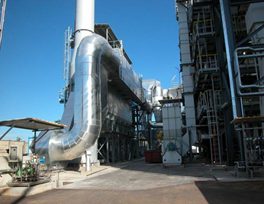Air treatment

In Italy, the quality of the air progressively improved, emissions of sulfur dioxide (SO2) and benzene (C6H6) decreased of around 90% in the period 1990 – 2012; the ones of carbon monoxide (CO) of 70%. The reduction of nitrogen oxide (as the sum of nitrogen monoxide NO and nitrogen dioxide NO2) and those of non-methane volatile organic composts (NMVOC) was higher than 50%; that one of PM10 was higher than 30%, while that one of ammonia (NH3) is less performing, but around 14%.
The need to limit pollutant in the air often requires the use of complex treatment systems.
These systems proved to be indispensable for industries that produce high quantity of airborne pollutants and want to be consistent with the principles of the BAT – Best Available Techniques.
The technologies developed in Italy are related to:
- Pre-depuration, that is a process often required in industrial factories and consists in a preliminary treatment of the contaminated air with partial reduction of pollutants; therefore, the pre-treated flows are conveyed to other more expensive and more effective treatment systems.the major pre-depuration systems are:
- Sedimentation Chambers;
- Cyclones and Multi-Cyclones.
- fabric filter (baghouse) is a process of particulate abatement that happens when the polluted air flow goes through filters made of textile fibers. There three kind of filters
- Mechanical Shaker Baghouses;
- Reverse Air (R/A) Baghouses;
- Pulse Jet Baghouses.
- The electrostatic precipitation is mainly used to reduce emissions of the pollutants in the form of particulates; in optimal conditions it is able to break down the particulate in suspension with an efficiency greater than 99%. Commonly there are 3 different types of electrostatic precipitators:
- Dry, negatively charged;
- Wet-walled, negatively charged;
- Two-stage, positively charged.
- In the abatement processes by condensation, the polluting vapors are removed from the contaminated air stream by changing its physical state from gas to liquid; once liquefied, these contaminants are easily separated and often reused in the production cycle. Commonly there are 3 different types of capacitors, divided on the basis of the substances used to cause the lowering of the temperature:
- conventional capacitors;
- refrigerant condensers;
- cryogenic condensers.
- The wet abatement systems process the removal of pollutants in a contaminated gaseous stream by the action of a liquid, usually water; for this reason similar installations are also defined washing systems. There are essentially four different types of plants:
- spray towers;
- plate scrubbers;
- packed-bed towers;
- venturi scrubbers.
- Combustion is used for removing organic contaminants in industrial gaseous emissions, when it is not possible to recover these compounds to reintroduce them into the production cycle, both for technical difficulties and for exclusively economic reasons. The most commonly used abatement systems in combustion are:
- flaring;
- thermic combustion;
- catalytic combustion.
- Adsorption is a phenomenon which consists in the adhesion and in the concentration of dissolved or aero-dispersed substances on the surface area of a body. The adsorption is generally used when the air is contaminated by one or two valuable compounds that need to be re-used in industrial processes; in this case the adsorbent material allows to collect and then to re-use these substances in the production cycle. Most common adsorbers are:
- Active carbob adsorbers
- Zeolite adsorbers
- The bio-filtration is a process of abatement of airborne pollutants that exploits the biological oxidation: the contaminated air flows through a medium, in which the microorganisms are capable of decomposing the pollutant by using them as a food source. The system allows to obtain the same results of combustion, with the exception that the oxidation of volatile organic compounds to carbon dioxide occurs not thermally but biologically; if the compounds contain sulfur, nitrogen or chlorine, then the oxidation by-products are mineral salts